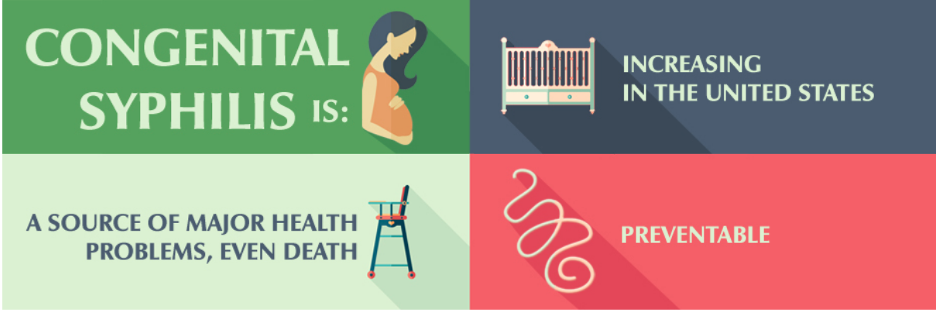
Syphilis Comeback? It Never Went Away
When I was in high school, our sex education classes included a section on sexually transmitted diseases, or STDs. The only ones I ever remember the teacher mentioning were syphilis and gonorrhea. Since those dark ages, the term has changed from STD to STI – sexually transmitted infections. STIs include among others, human papillomavirus (HPV), herpes, chlamydia, and HIV. But for some reason, we stopped hearing about syphilis and gonorrhea.
Syphilis is in the headlines again though. Cases are on the rise, and not only is it affecting sexually active adults, but the infection is also seriously impacting newborns.

https://www.cdc.gov/std/syphilis/stdfact-congenital-syphilis.htm
Cases are rising
Syphilis is a reportable disease, which means if you are diagnosed with the infection, it must be reported to a central database. According to the Centers for Disease Control and Prevention (CDC), there were 101,590 cases in the U.S. in 2017. The numbers increased over the next few years, with 176,713 cases reported in 2021. Treatment is simple. In the early stages, the usual treatment is a one-time injection of penicillin. If you’ve had it longer, it would take one weekly injection per week for three weeks.
A sneaky infection
Some people call syphilis the “great pretender” because when symptoms occur, it’s easy to think another infection caused them. The infection also isn’t always top of mind, mainly because the first symptom can take as long as three months to show up (from 10 to 90 days, with an average of 21 days). It also doesn’t help if some healthcare providers don’t consider certain patients to be at risk for contracting syphilis.
There are four stages: primary, secondary, latent, and a rare type called tertiary.
Primary is the first stage, when the symptoms show up within 10 to 90 days of exposure. But the symptoms may not be obvious. You can develop a painless chancre (ulcer, break in the skin), but you may never notice it because it’s usually painless and is often where you may not see it (vagina or anus, for example).
This chancre heals within three to six weeks, even if you don’t get treatment. But that doesn’t mean the infection is gone. It’s still there, and without antibiotics, it will progress to the next stage.
The secondary stage can appear in as few as two weeks or as long as six months after that chancre has healed. It usually causes a rash or sores in the mouth, vagina or anus. For some people, the rashes are very faint and can occur on the palms of the hands and the soles of the feet. You could also have:
- Fever
- Swollen lymph nodes
- Sore throat
- Hair loss
- Headaches
- Weight loss
- Muscle aches
- Fatigue
So, given how much time there can be between the infection and the vagueness of the symptoms, it is easy to see why you might not connect them with the possibility of having an STI. There are many illnesses and infections that have similar symptoms. These include:
- Mononucleosis
- Autoimmune diseases, such as lupus or rheumatoid arthritis
- Endocrine issues, like thyroid dysfunction
- Some types of cancer
As with primary syphilis, the secondary symptoms eventually go away without treatment. But also like primary syphilis, the infection is still there, dormant. It will lead to the latent, or third stage.
If you have had a syphilis infection for 12 months or more, you have latent, or hidden, infection. There are no symptoms, but you can spread the infection to others. Eventually, latent syphilis can lead to tertiary syphilis.
Tertiary syphilis can cause serious complications in the organs, including the brain and heart, as well as other body parts like the blood vessels and joints. It can appear anywhere from 10 to 30 years after the initial infection.
Syphilis in pregnancy
 As a sexually transmitted infection, it is only spread through sexual activity if you come into contact with a syphilis sore. However, if you have the infection while pregnant, you can infect the baby. This is congenital syphilis. Transmission to the baby can be prevented though, by early diagnosis and treatment.
As a sexually transmitted infection, it is only spread through sexual activity if you come into contact with a syphilis sore. However, if you have the infection while pregnant, you can infect the baby. This is congenital syphilis. Transmission to the baby can be prevented though, by early diagnosis and treatment.
According to the CDC, cases of congenital syphilis have tripled with over 2000 cases in 2021.
Anyone who is pregnant should be tested for syphilis – the earlier in the pregnancy, the better. The CDC recommends testing at the first prenatal visit. According to the March of Dimes, “If you’re pregnant, have syphilis and get treated for syphilis before 26 weeks of pregnancy, your baby is probably safe from the infection.” If you do have the infection, treatment with penicillin has a 98% success rate in preventing transmission to the baby.
You can get syphilis more than once. Partners should be treated as well to prevent reinfection. Depending on the situation, some people need retesting later in their pregnancy, whether they had it or not earlier.
Unfortunately, untreated infection during pregnancy can result in miscarriage, a stillbirth, or the baby can die shortly after birth. This happens in about 40% of cases. The babies who do survive are likely to be born with congenital syphilis. This can cause many medical problems, including bone damage, enlarged liver, blindness, deafness, and more.
Syphilis is preventable
Syphilis is a preventable STI. You get it if you have sex with someone who has it – knowingly or not – and you come into contact with a chancre or sore. It’s easy to say that you can’t get an STI if you don’t have sex, but we must also be realistic! It’s essential to keep in mind that you can’t always see a chancre, and people with syphilis don’t always know they have it. So, it’s best to go into such a relationship with the mindset of always protecting yourself. That means using latex condoms—every time.
Disclaimer
The information in this blog is provided as an information and educational resource only. It is not to be used or relied upon for diagnostic or treatment purposes.
The blog does not represent or guarantee that its information is applicable to a specific patient’s care or treatment. The educational content in this blog is not to be interpreted as medical advice from any of the authors or contributors. It is not to be used as a substitute for treatment or advice from a practicing physician or other healthcare professional.



